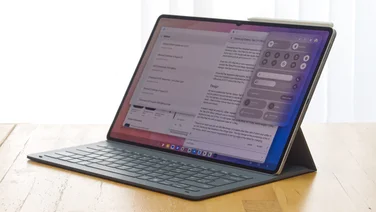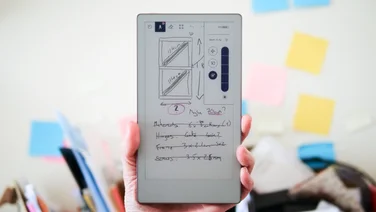To help us provide you with free impartial advice, we may earn a commission if you buy through links on our site. Learn more
- Apple iPad 10th generation (2022) review: What you need to know
- Apple iPad 10th generation (2022) review: Price and competition
- Apple iPad 10th generation (2022) review: Design and key features
- Apple iPad 10th generation (2022) review: Display
- Apple iPad 10th generation (2022) review: Performance and camera
- Apple iPad 10th generation (2022 review): Verdict












- USB-C
- Updated design
- Repositioned webcam
- Keyboard case is pricey
- 1st-gen Apple Pencil support
- Only slightly faster than 9th-gen iPad
A lot of the noise surrounding the launch of the 10th-generation Apple iPad has focused on how confusing Apple’s tablet lineup has become – and it’s easy to see why. With this latest addition to the family, Apple now has six different models in the iPad range, four of which have very similar screen sizes and three of which look all but identical to one another.
For a company that usually prides itself on the clarity of its product ranges, each model with its own unique appeal, this is somewhat out of character. And, if nothing else, it certainly makes buying an iPad more complicated than it used to be.
Apple iPad 10th generation (2022) review: What you need to know
So where does the 10th-generation iPad sit in this peculiar sub-range of 10-11in Apple tablets? Well, if you visualise the lineup as a (short) league table and sort by price, the new iPad sits in third place, with the 9th-generation iPad just below it in fourth and the iPad Air just above it in second. Naturally, the 11in M2 iPad Pro tops the table.












There’s a £130 to £170 difference in price between each model; the differences in specification are quite subtle. Paying more gets you a faster CPU, better quality screen and improved accessory compatibility.
Visually, the new iPad doesn’t break the mould. It’s almost identical in appearance to the iPad Air, apart from the fact that it’s available in different colours: blue, pink, silver and yellow. It has a 10.9in display with the same resolution as the Air – 2,360 x 1,640 – the same sharpness (264ppi) and the same 60Hz refresh rate. Where it differs is that the LCD panel isn’t laminated to the top glass. Like the cheaper 10.2in iPad, there’s a small gap between the two, which can affect image quality in certain circumstances.
There’s also a slightly slower A14 Bionic chip inside, where the Air has an M1 chip, and the new iPad only supports the first-generation Apple Pencil, where the Air supports the second generation.












Last, but by no means least, Apple has also introduced a new Magic Keyboard Folio case for the 10th-generation iPad. This comes in two parts, the rear portion attaches to the rear magnetically and has a kickstand, while the separate keyboard and touchpad attaches to the three pin smart connector on the front lip of the tablet.
READ NEXT: The best smartphones to buy
Apple iPad 10th generation (2022) review: Price and competition
As I’ve already mentioned, when it comes to price, the 10th-gen iPad is the third most expensive among Apple’s 10-11in tablets. Prices start at £499, which is £130 more than the older 9th-generation iPad and £170 cheaper than the iPad Air.
As with most of Apple’s iPad range there are various options available to you, determined by how much storage you want and whether you’re after cellular connectivity or not. The base price of £499 is for the model with 64GB, while the 256GB model costs £679. Cellular connectivity adds a further £179 to the price.












And don’t forget to add the cost of a keyboard: the Magic Keyboard Folio is £279 and the Apple Pencil (1st generation) is another £109. Note that if you don’t want to pay Apple’s exorbitant prices, Logitech’s Combo Touch keyboard case does an equally good job for £180.
All of this brings the overall price for the 10th-gen Apple iPad to £778 for the tablet and keyboard and £887 for the tablet and keyboard and Apple Pencil. That’s a healthy chunk of cash and works out £240 more expensive than buying the 9th-generation iPad with the Smart Keyboard Folio – the one without the touchpad.
As for alternatives, those come mostly from Apple’s own ranks and the 9th-generation iPad provides the stiffest challenge. It comes with a slightly smaller display and a slower, year older A13 Bionic chip but, functionally, you can do pretty much anything on it that you can on the redesigned model and it’s £130 cheaper.












As for Android tablets, that situation is the same as ever. There are some manufacturers building decent productivity tablets, such as Samsung and recently Xiaomi, but Android as a tablet operating system still lags behind iPadOS in terms of its maturity and the availability of tablet-specific apps.
At £649, the Samsung Galaxy Tab S8 is the strongest opposition. This price includes the stylus and you’ll need to pay £119 extra if you want the official Samsung keyboard case (the Keyboard Slim Book Cover). That’s cheaper than the 10th-gen iPad plus the Tab S8 comes with an OLED screen.
Apple iPad 10th generation (2022) review: Design and key features
You’ll probably be quite familiar with the “all new” design of the 10th-gen iPad as it follows the design cues initially set out by the iPad Pad Pro redesign of 2018. It has an edge-to-edge display with fairly narrow black bezels that are the same width all the way around, the edges are rear are completely flat and there’s a single camera on the rear of the unit.












The speaker grilles are placed on each short edge of the tablet so they fire left and right when using the tablet in landscape orientation and the power and volume buttons are located in the same locations as they have been since the very first iPad. If you hold the tablet in landscape mode, the power button is on the left edge at the top and the volume buttons are just around the corner on the top edge over to the left hand side.
One thing to be aware of here is that, like the iPad Air, the 10th-generation iPad does not have a Face ID camera. Instead, it has a Touch ID fingerprint reader built into the power button. I’m not a fan of its placement and you need to register at least two fingerprints to use it comfortably in both portrait and landscape orientations, otherwise you’ll end up contorting yourself into all sorts of uncomfortable positions to unlock the tablet.
Another thing that isn’t exactly perfect – actually, no, that’s putting it kindly, it’s bafflingly nonsensical – is that the new iPad supports only the first generation Apple Pencil, despite having upgraded from the ageing Lightning connector to USB-C. I’m a big advocate of moving to USB-C but this strange halfway house means you’ll have to use the supplied Lightning to USB-C adapter if you want to charge your Apple Pencil from the tablet itself, which is a clunky workaround.












Whoever sanctioned that particular move is responsible for the most user unfriendly piece of design I can remember Apple making in the last few years. Fortunately, it is also, by far, the 10th-generation iPad’s worst feature and elsewhere the upgrades are largely positive.
I particularly like that Apple has moved the front camera from the top of the short edge over to the top, long edge. This means that, finally, you can participate in video calls in laptop mode without the camera looking at you sideways. It’s something Apple should have done a long time ago and image quality is pretty good.
The 12MP f/1.8 rear camera is equally good. Images captured with it are inevitably a little on the noisy side in low light but, generally, images captured in good light are clean, sharp, detailed and well exposed. Video can be captured at 4K resolution, up to 60fps fully stabilised, too, although not in Dolby Vision HDR as Apple’s iPhones are capable of.












And, setting aside its rather high price, the new keyboard is also rather nicely made and designed. Unlike previous cases, it’s a two-piece design with the rear panel/kickstand and keyboard attaching separately. This has its advantages and disadvantages. The good thing about it is that the keyboard can be removed and flipped around, allowing you to store the keyboard flat against the rear of the iPad without the keys being exposed. What I don’t like is that, with the kickstand folded out at the rear, the iPad becomes rather cumbersome and tricky to use on your lap. The one piece Magic Keyboard is a more compact and elegant design but it isn’t compatible with the 10th-generation iPad.
Having said that, the keyboard itself is perfectly pleasant to type on. It’s backlit, has a lightweight action with a fairly positive click and I found myself up to a fairly quick touch typing speed without much readjustment. The layout makes sensible compromises between compactness and usability, and the only keys suffering serious shrinkage are those you use less often. The touchpad also works nicely, giving just enough space for comfortable swiping, scrolling and pointing, without being overly large.
READ NEXT: The best Apple iPhones to buy
Apple iPad 10th generation (2022) review: Display
One of the main reasons you might choose one tablet over another is the display but not here. The screen on the 10th-generation iPad might be slightly larger and have a higher resolution at 2,360 x 1,640 than the older 9th-generation model but that’s where the differences end.
Elsewhere, similarities abound: it’s exactly the same sharpness at 264ppi, it has the same 60Hz refresh rate and reproduces only up to sRGB. The iPad Air’s display is more vibrant and capable of producing the wider palette of the P3 colour gamut.












In testing the display produced 89.5% of sRGB with a decent level of colour accuracy, with an average Delta E colour difference score of 1.27 (lower is better). A contrast ratio of 1,097:1 rounds off a decent but hardly stellar showing; if you’re after the very best display performance, I’d recommend you step up to an iPad Pro 12.9in, which has a mini-LED screen (if you can get hold of an M1 model for less that would be the one to go for) or the Samsung Galaxy Tab S8, which has an OLED panel.
Otherwise, specifications are very much the same as the older tablet with peak brightness quoted at 500cd/m2 (I measured it at 520cd/m2) and Apple’s wonderful True Tone ambient colour matching technology to keep eyestrain under control. The modest peak brightness level and limited colour gamut means that you won’t see a particularly impactful HDR performance, although Netflix, Disney Plus and so on hardly look bad on the display.
Apple iPad 10th generation (2022) review: Performance and camera
The 10th-generation iPad is powered by the Apple A14 Bionic chip, which is the same chip used in the previous generation of iPad Air and in the iPhone 12 generation of smartphones.
It’s a six-core chipset with an four-core GPU and, surprise, surprise it performs precisely as you’d expect it to: slightly faster than the 2021 iPad 9th generation and slightly slower than the M1 iPad Air.


That might sound a bit old hat but it still holds its own and for the majority of tasks, performance is absolutely fine. The biggest issue, if you can call it as much, is that the 60Hz display feels a little sluggish in transition compared with the 120Hz display on the iPad Pro.
As for battery life, that’s about what I’d expect from an iPad. It lasted 11hrs 52mins in our video playback test with the display set to a brightness of 170cd/m2 and flight mode engaged. That places it just behind the standard iPad, ahead of the iPad Air and about on a par with the Samsung Galaxy Tab S8.

Apple iPad 10th generation (2022 review): Verdict
It’s debatable whether Apple needed to introduce yet another 10-11in tablet but the iPad 10th generation does a very good job of justifying its existence. It’s nippy enough for everyday apps and productivity tasks, it’s well made, the screen is excellent and the cameras are good, too, particularly the front facing one, which has finally been moved to where it should be for a productivity tablet.
It isn’t without its problems. I’m not a fan of the way you need to use an adapter to charge the first-generation Apple Pencil. Plus, when you boil it down, it isn’t that much more accomplished than the 9th-generation model that went before it, and especially not given the £130 premium.
It’s not a bad tablet, then – far from it, it’s very good – but if you’re looking for a cheap iPad, I’d recommend you buy a 9th-generation model while they’re still available.
| Apple iPad 10th generation specifications | |
|---|---|
| Processor | Hexa-core Apple A14 Bionic (2x performance, 4x efficiency cores) |
| RAM | 6GB |
| Screen size | 10.9in |
| Screen resolution | 2,560 x 1,640 |
| Pixel density | 264ppi |
| Screen type | IPS |
| Screen refresh rate | 60Hz |
| Front camera | 12MP, f/2.4 |
| Rear camera | 12MP, f/1.8 |
| Flash | No |
| Dust and water resistance | No |
| 3.5mm headphone jack | No |
| Wireless charging | No |
| USB connection type | USB-C |
| Storage options | 64GB; 256GB |
| Memory card slot (supplied) | No |
| Wi-Fi | Wi-Fi 6 |
| Bluetooth | 5.2 |
| NFC | No |
| Cellular data | 5G (only cellular models) |
| Dual SIM | Yes, via eSIM |
| Dimensions (WDH) | 249 x 7 x 180mm |
| Weight | 477 (Wi-Fi); 481g (Wi-Fi and cellular) |
| Operating system | iPadOS 16 |
| Battery size | 28.6Wh |







